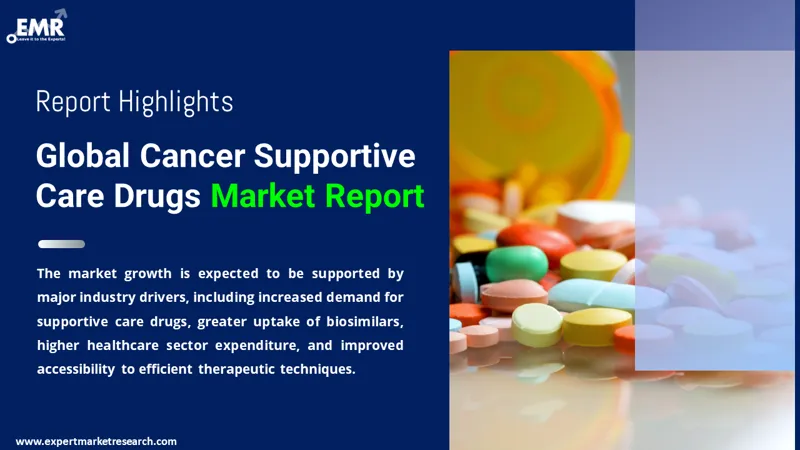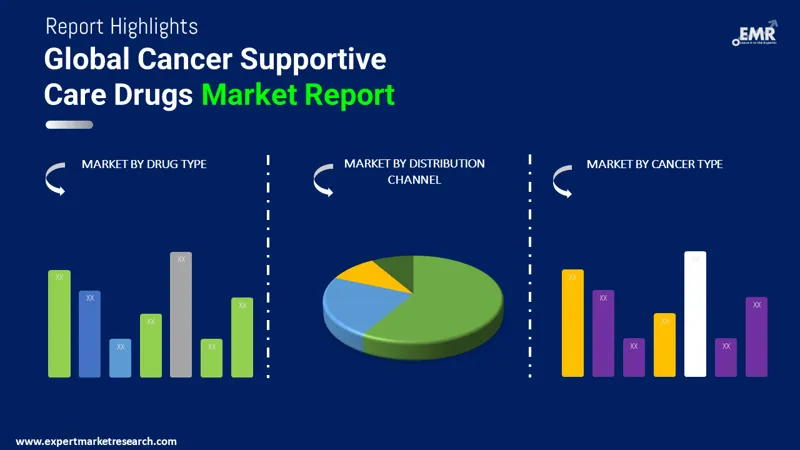
Consumer Insights
Uncover trends and behaviors shaping consumer choices today
Procurement Insights
Optimize your sourcing strategy with key market data
Industry Stats
Stay ahead with the latest trends and market analysis.
The cancer supportive care drugs market was valued at USD 21.67 Billion in 2025, driven by the rising prevalence of cancer and the increasing demand for palliative care solutions. The market is anticipated to grow at a CAGR of 2.30% during the forecast period of 2026-2035, with values likely to reach USD 27.20 Billion by 2035.
Base Year
Historical Period
Forecast Period
Compound Annual Growth Rate
2.3%
Value in USD Billion
2026-2035
*this image is indicative*
It is estimated that the global cancer burden has risen to 18.1 million new cases and 9.6 million deaths in 2018. The most prominent kinds of cancer with the greatest demand for supportive care drugs are lung and breast cancer.

Read more about this report - REQUEST FREE SAMPLE COPY IN PDF
The global cancer supportive care drugs market can be broadly categorised on the basis of its drug class into:
Market Breakup by Drug Type
Market Breakup by Cancer Type
Market Breakup by Distribution Channel
Market Breakup by Region

Read more about this report - REQUEST FREE SAMPLE COPY IN PDF
It is anticipated that increased biosimilar uptake, a large number of side effects connected with cancer treatment, increased expenditure on the healthcare sector, and the accessibility to the efficient therapeutic techniques, including target-specific and tailored treatments, are driving the global cancer supportive care drugs industry further. China and India are promising locations for the development of the cancer supportive care drugs industry. Factors such as increasing biosimilar uptake, effective healthcare reforms, and low-cost bases are providing a boost to the market in these two nations.
The report presents a detailed analysis of the following key players in the global cancer supportive care drugs market, looking into their capacity, market shares, and latest developments like capacity expansions, plant turnarounds, and mergers and acquisitions:
The EMR report gives an in-depth insight into the industry by providing a SWOT analysis as well as an analysis of Porter’s five forces.




*While we strive to always give you current and accurate information, the numbers depicted on the website are indicative and may differ from the actual numbers in the main report. At Expert Market Research, we aim to bring you the latest insights and trends in the market. Using our analyses and forecasts, stakeholders can understand the market dynamics, navigate challenges, and capitalize on opportunities to make data-driven strategic decisions.*
Get in touch with us for a customized solution tailored to your unique requirements and save upto 35%!
The market was valued at USD 21.67 Billion in 2025.
The market is anticipated to grow at a CAGR of 2.30% during the forecast period of 2026-2035, with the values likely to reach USD 27.20 Billion by 2035.
The major drivers of the industry, such as the rising demand for supportive care drugs, increased biosimilar uptake, increased expenditure on the healthcare sector, and the rising accessibility to efficient therapeutic techniques, are expected to aid the market growth.
The key market trend guiding the industry growth includes the development of the cancer supportive care drugs.
The major regions in the industry are North America, Latin America, the Middle East and Africa, Europe, and the Asia Pacific.
The leading drug classes of the product in the industry are G-CSFs, erythropoietin stimulating agents (ESA), antiemetics, bisphosphonates, opioids, and NSAIDs, among others.
The major players in the industry are HELSINN Healthcare SA, F. Hoffmann-La Roche AG, Merck & Co., Inc., Amgen Inc., and Novartis International AG, among others.
Explore our key highlights of the report and gain a concise overview of key findings, trends, and actionable insights that will empower your strategic decisions.
| REPORT FEATURES | DETAILS |
| Base Year | 2025 |
| Historical Period | 2019-2025 |
| Forecast Period | 2026-2035 |
| Scope of the Report |
Historical and Forecast Trends, Industry Drivers and Constraints, Historical and Forecast Market Analysis by Segment:
|
| Breakup by Drug Type |
|
| Breakup by Cancer Type |
|
| Breakup by Distribution Channel |
|
| Breakup by Region |
|
| Market Dynamics |
|
| Supplier Landscape |
|
| Companies Covered |
|
Single User License
One User
USD 5,499
USD 4,949
tax inclusive*
Datasheet
One User
USD 3,299
USD 2,969
tax inclusive*
Five User License
Five User
USD 6,999
USD 5,949
tax inclusive*
Corporate License
Unlimited Users
USD 8,199
USD 6,969
tax inclusive*
*Please note that the prices mentioned below are starting prices for each bundle type. Kindly contact our team for further details.*
Flash Bundle
Small Business Bundle
Growth Bundle
Enterprise Bundle
*Please note that the prices mentioned below are starting prices for each bundle type. Kindly contact our team for further details.*
Flash Bundle
Number of Reports: 3
20%
tax inclusive*
Small Business Bundle
Number of Reports: 5
25%
tax inclusive*
Growth Bundle
Number of Reports: 8
30%
tax inclusive*
Enterprise Bundle
Number of Reports: 10
35%
tax inclusive*
How To Order

Select License Type
Choose the right license for your needs and access rights.

Click on ‘Buy Now’
Add the report to your cart with one click and proceed to register.

Select Mode of Payment
Choose a payment option for a secure checkout. You will be redirected accordingly.
Gain insights to stay ahead and seize opportunities.

Get insights & trends for a competitive edge.

Track prices with detailed trend reports.

Analyse trade data for supply chain insights.

Leverage cost reports for smart savings

Enhance supply chain with partnerships.

Connect For More Information
Our expert team of analysts will offer full support and resolve any queries regarding the report, before and after the purchase.
Our expert team of analysts will offer full support and resolve any queries regarding the report, before and after the purchase.
We employ meticulous research methods, blending advanced analytics and expert insights to deliver accurate, actionable industry intelligence, staying ahead of competitors.
Our skilled analysts offer unparalleled competitive advantage with detailed insights on current and emerging markets, ensuring your strategic edge.
We offer an in-depth yet simplified presentation of industry insights and analysis to meet your specific requirements effectively.
Share